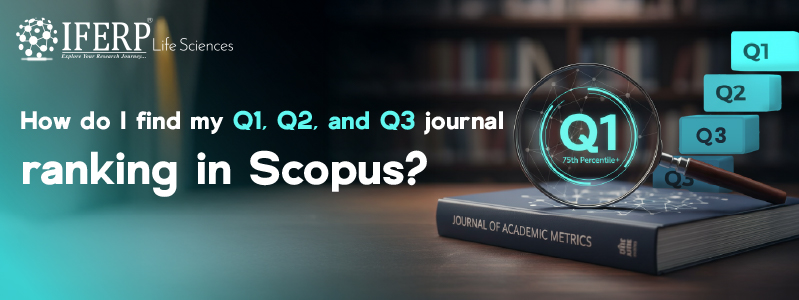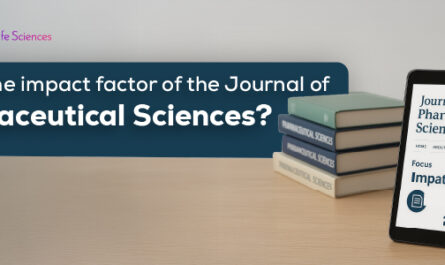Publishing in a Scopus indexed journal with a high reputation, detailed reviews, and top-quality research enhances your authenticity, academic reputation, and recognition. It is one of the most respected indexing databases. Its journals are distributed into Q1, Q2, Q3, and Q4 quartiles, which shows its ranking and quality.
If you want to find your Scopus Q1, Q2, Q3, Q4 journal ranking, then this blog will help you find your journal ranking and understand the quartile ranking concept.
Table Content
- Understanding Quartile Journal Rankings
- Importance of Quartile Rankings for Researchers
- How to Find Q1, Q2, Q3, and Q4 Journal Rankings in Scopus
- Understanding from an Example
- Tips to Choose the Right Journal
Main Body
Understanding Scopus Quartile Journals Ranking
Before knowing your journal ranking in Scopus, you have to first briefly understand each Scopus quartile. Scopus has divided its journal ranking into four quartiles as Q1, Q2, Q3, and Q4. Let’s understand them:
Q1 journals (Top 25%)
These journals have the highest rank of journals published in their field. They are highly respected and recognised around the world. Known for its effective research.
Q2 journals (Top 25% – 50%)
These journals are among the top 25% and 50% journals. They also have good research quality and authenticity. Also, have a recognition of the academic community.
Q3 journals (Top 50% – 75%)
These journals lie between 50% to 75% journals. Have an average recognition but are still reputable. Suitable for related and engaging topics. Still considered reputable and detail reviewed.
Q4 journals (Bottom 25%)
These lower 25% journals have limited recognition, but are also indexed and detail reviewed. These journals provide you with an authentic platform for your early career research and advanced studies.
These quartiles are organised in resources such as Q1, Q2, Q3, Q4 journal list, Q1 q2 q3 q4 journal list pdf, and the Scopus impact factor list of journals. It can provide you with a better understanding of the Scopus quartile ranking so that you can choose the right journal for your effective article publication.
Importance of Scopus Quartile Rankings for Researchers
The quartile journal rankings not only show the authenticity but also enhance your research visibility and reputation. This is why Scopus quartile journal rankings are very important for your publication:
- Academic reputation: Journals of Scopus Q1 journal list or Q1 and Q2 journals list areworldwide recognised for their authentic research
- Citation & Recognition: Articles of Scopus Q1, Q2, Q3 Q4 journals have great chance of recognition
- Career Development: Publishing in top quartile journals may help you in support, recognition and research funds from experts
- Worldwide Collaboration: Q1 journals help you in making global collaboration to provide you with international reach and new opportunities
These quartile rankings help you in making the best decision to increase your career growth and future collaboration.
How to Find Q1, Q2, and Q3 Journal Ranking in Scopus
To know the ranking of your journal, you have to check the official sources. It helps you identify the trusted journals. There are some methods you can follow to find your journal’s ranking:
By using Scopus Sources
Using the official Scopus Sources tool can help you in finding authentic journals. It is the most trusted way to find the journal ranking in Scopus. To check the journals, you have to follow these steps:
- Visit the official Scopus Sources tool
- Write your journal’s name or ISSN
- Check the CiteScore, SJR, and SNIP of your journal
- Confirm its quartile to check if it shows in the Scopus Q1 journal list or Q1 q2 q3 q4 journal list scopus
This method gives you the latest and accurate information on your journal’s ranking. It prevents the risk of your publication in predatory journals.
Using SCImago Journal Rank (SJR)
SCImago is a free and very authentic tool. You can also easily find the quartile ranking of journals from it. Follow the steps below:
- Go to the SCImago Journal Rank (SJR) website – scimagojr.com
- Search your journal by entering the name or ISSN
- Verify its quartile in the subject field
- Check the journal’s presence in scopus q1 journals, Q1 q2 q3 q4 journal list pdf, or Scopus quartiles q1 q2 q3 and q4 journals list free
SCImago helps researchers with free access. If you don’t have a Scopus subscription, then it can provide you with journal information for free.
Downloading Q1 Q2 Q3 Q4 Journal List PDF
Apart from the tools, there are also Q1, Q2, Q3, and Q4 Journal List organized PDFs. It is provided by many universities and research institutions, divided into quartiles.
This list has the journal’s name, ISSN, publisher, quartile, and occasionally Scopus impact factor list of journals. These PDFs help you in filtering and selecting journals according to your subject field and ranking.
If you have a PDF list of journals, then it can save you time. It also helps you in the preparation of your submission. You can also compare many journals before selecting your preferred one.
Verify Around Multiple Sources
Even if your journal shows in a specific quartile of Scopus, it doesn’t mean that it has a high rank. Its rank may be different in other databases like Web of Science, which uses Journal Citation Reports (JCR).
Double verification of a journal is very important because it gives you an exact understanding of its worldwide reputation. It also avoids differences that may influence your future funding and collaboration. Moreover, it provides you knowledgeable decision on your research paper submission. You can use these tools to double-check your journal in multiple databases:
- Scopus Sources
- SCImago Journal Rank (SJR)
- Web of Science JCR
Understand From an Example
Example 1
Let’s suppose you selected the Journal of Cleaner Production to publish your research paper in. Then the metrics of this journal are like:
- SCImago shows a 2.9 score of SJR
- Q1 rank in the Environmental Science field
- Present in the Scopus Q1 journal list and the Scopus impact factor list of journals
At the same time, a smaller journal may be considered as Q3, having authenticity but with average recognition. So, understanding the journals by an example can help you make decisions according to your research goals, audience and preferred result.
Example 2
Think that you selected the International Journal of Environmental Research and Public Health (IJERPH) for your article publication:
- SCImago shows a 1.8 score of SJR
- Q2 rank in the Environmental Science and Public Health
- Present in both Scopus and Web of Science
This journal holds a good reputation and recognition, but it is a little less effective compared to Q1 journals. Suitable for researchers looking for recognition, having averagly broad audience.
Tips to Choose the Right Journal
There are many factors you should carefully consider to select the right journal for your publication. See what factors you should consider:
- Always match your research paper with the scope and goal of the journal. An off-topic research paper may lead you to quick rejection.
- Make sure to check the ranking of your journal in Scopus Q1 journal list, Q1 and Q2 journals list, or the Q1 q2 q3 q4 journal list Scopus. It provides you with authenticity and prevents you from predatory publishers.
- Avoid publishing in journals of Scopus quartiles q1 q2 q3, and q4 journals list free, because they may have less authenticity.
- To understand the journal’s aim and style, you can study the latest published articles so that your research fits in with it.
- To compare the journals faster by quartile, subject field and impact, you can use the Q1 q2 q3 q4 journal list pdf.
By considering these factors, you can increase the acceptance chances of your research work. It also brings your research to the most suitable and effective audience. Using official lists is the best idea to protect your work.
Conclusion
In the competition of academic publishing, it is very important to find the right journal. Choosing the right journal can increase the research visibility, credibility, and reach. Some resources, like Q1, Q2, Q3, Q4 journal list, the Scopus Q1 journal list, and the Scopus impact factor list of journals, help in analyzing and selecting the journals thoroughly.
Submitting your research work in a journal without verifying its ranking may waste your time and efforts. Using tools such as Q1 q2 q3 q4 journal list PDF and checking the Scopus Q1, Q2, Q3 Q4 rankings enhances your academic reputation.
FAQs
You can use Scopus Sources or SCImago Journal Rank to verify the journal indexing in Scopus.
Scopus quartile journals are ranked according to CiteScore/SJR, whereas Web of Science quartile journals are ranked according to impact factor.
Yes, you can download it from the SCImago Journal Rank or university resources.
No, it is not compulsory. But publishing in Q1 and Q2 journals can enhance your career and future growth rapidly in comparison to Q3 and Q4.




